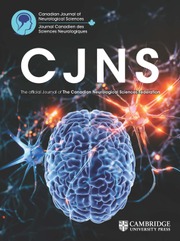Article contents
Spontaneous Internal Carotid Artery Dissection with Lower Cranial Nerve Palsy
Published online by Cambridge University Press: 02 December 2014
Abstract
Typical presentation of spontaneous internal carotid artery (ICA) dissection is an ipsilateral pain in neck and face with Horner's syndrome and contralateral deficits. Although rare, lower cranial nerve palsy have been reported in association with an ipsilateral spontaneous ICA dissection.
We report three new cases of ICA dissection with lower cranial nerve palsies.
The first symtom to appear was headache in all three patients. Examination disclosed a Horner's syndrome in two cases (1 and 2), an isolated XIIth nerve palsy in two patients (case 1 and 3) and IX, X, and XIIth nerve palsies (case 2) revealing an ipsilateral carotid dissection, confirmed by MRI and angiography. In all cases, prognosis was good after a few weeks.
These cases, analysed with those in the literature, led us to discuss two possible mechanisms: direct compression of cranial nerves by a subadventitial haematoma in the parapharyngeal space or ischemic palsy by compression of the ascending pharyngeal artery.
Résumé:
Le diagnostic de dissection de l'artère carotide interne (ACI) est le plus souvent évoqué devant l'association d'une douleur cervicale et d'un syndrome de Horner homolatéraux associés à un déficit moteur de l'hémicorps controlatéral. Plus rarement, une dissection carotidienne peut s'accompagner d'une paralysie homolatérale des derniers nerfs crâniens.
Nous décrivons 3 nouveaux cas de paralysie des derniers nerfs crâniens associée à une dissection de l'ACI.
Dans les trois cas une douleur céphalique fut le premier signe à apparaître, l'examen clinique mit en évidence un signe de Horner chez deux patients (1 et 2), une paralysie isolée du XIIe dans deux cas (1 et 3), et des IXe, Xe, Xlle nerfs crâniens dans un cas (2). Le diagnostic de dissection de l'ACI homolatérale fut confirmé par l'IRM et l'angiographie. L'évolution fut favorable en quelques semaines dans les trois cas.
En analysant ces trois observations conjointement avec celles de la littérature, deux hypothèses physiopathologiques peuvent être proposées: un mécanisme compressif direct ou un mécanisme ischémique par compression de l'artère pharyngienne ascendante.
- Type
- Case Report
- Information
- Copyright
- Copyright © The Canadian Journal of Neurological 2001
References
- 20
- Cited by


